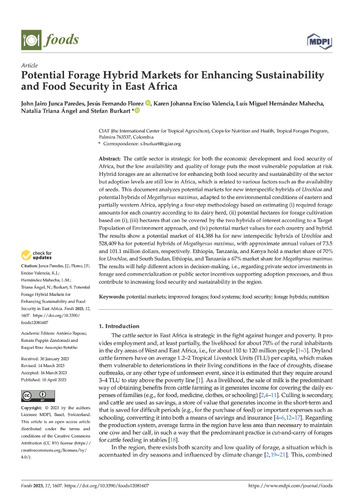Potential forage hybrid markets for enhancing sustainability and food security in East Africa
The cattle sector is strategic for both the economic development and food security of Africa, but the low availability and quality of forage puts the most vulnerable population at risk. Hybrid forages are an alternative for enhancing both food security and sustainability of the sector but adoption levels are still low in Africa, which is related to various factors such as the availability of seeds. This document analyzes potential markets for new interspecific hybrids of Urochloa and potential hybrids of Megathyrsus maximus, adapted to the environmental conditions of eastern and partially western Africa, applying a four-step methodology based on estimating (i) required forage amounts for each country according to its dairy herd, (ii) potential hectares for forage cultivation based on (i), (iii) hectares that can be covered by the two hybrids of interest according to a Target Population of Environment approach, and (iv) potential market values for each country and hybrid. The results show a potential market of 414,388 ha for new interspecific hybrids of Urochloa and 528,409 ha for potential hybrids of Megathyrsus maximus, with approximate annual values of 73.5 and 101.1 million dollars, respectively. Ethiopia, Tanzania, and Kenya hold a market share of 70% for Urochloa, and South Sudan, Ethiopia, and Tanzania a 67% market share for Megathyrsus maximus. The results will help different actors in decision-making, i.e., regarding private sector investments in forage seed commercialization or public sector incentives supporting adoption processes, and thus contribute to increasing food security and sustainability in the region.

